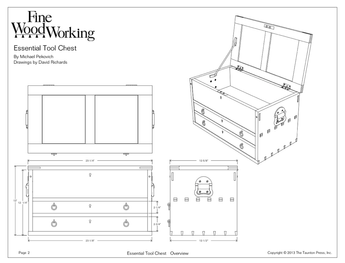Does anyone know how to wire an outlet such that when the power tool (top receptacle)is turned on the shop vac (bottom receptacle) is also turned on
Discussion Forum
Get It All!
UNLIMITED Membership is like taking a master class in woodworking for less than $10 a month.
Start Your Free TrialCategories
Discussion Forum
Digital Plans Library
Member exclusive! – Plans for everyone – from beginners to experts – right at your fingertips.
Highlights
-
Shape Your Skills
when you sign up for our emails
This site is protected by reCAPTCHA and the Google Privacy Policy and Terms of Service apply. -
 Shop Talk Live Podcast
Shop Talk Live Podcast -
 Our favorite articles and videos
Our favorite articles and videos -
E-Learning Courses from Fine Woodworking
-
-
 Fine Woodworking New England Event
Fine Woodworking New England Event -












Replies
I don't think you can do it by wiring the outlet in the way it seems that you are thinking.
A possible solution could be to use a sound activated switch on the shopvac. When you start a tool the vac would start. Obviously it would start up when any noisy tool operated, which might not be what you want.
If I were doing this I would also consider:
Wire the coil of a Normally Closed relay across the terminals of the socket into which the tool is to be plugged it. If the tool is OFF then the relay is powered and the shop vac is off.
When the tool is powered, the voltage across the relay coil drops, the relay closes and turns on the shop vac.
However this has the disadvantage that the relay spends most of its time on and could get quite hot. You would have to select the relay carefully. It has to be sensitive enough to operate when you power up the tool and rugged enough to not overheat, even if you forget to power it off.
You might want to consult an electrician on this one.
Hope this helps a little.
Big Boss,
Here's the easiest way to do what you want. And it's on sale right now. $29.00.
http://www.rockler.com/product.cfm?page=17351&cookietest=1
Zolton
If you see a possum running around in here, kill it. It's not a pet. - Jackie Moon
I'd go for the switch that Zolton "found". It looks like a neat idea and cuts out all the messing about.
I have had one of those outlet switches for a couple of years... I use it for my sanders and bandsaw and love it- particularly when I need to turn the sander or saw on and off frequently-
Jeff
The problem with the plug in switches is that if you try to run both the vacuum, and a larger power tool, say a "3-hp" router, you are eally taxing the swtich. My circuits are 20-amp. The switches sold at Sears and Rockler are 15-amp. So I can plug both the vacuum and router in with out tripping the breaker. But, the switch drops the voltage enough that the vacuum doesn't get enough voltage and the shop vac cooks it's motor.
Looks like you're up against a fundamental limitation of a 110V system.You need to have the Vac and the tool on different circuits. Going back to the sound operated idea, have a look at http://www.discovercircuits.com/S/sou-operate.htmMaybe you could cook something up using this info.
Boss Man,
I have a solution which works like a charm, but I can't take credit for it, myself. Check out magazine #143,
Dust Detector
Switch automatically turns on dust collector when machines are running
by Robert S. Wright
He goes into detail for setting up a current sensor in your panel or subpanel. You can select the amperage at which this sensor will then send a relay to another switch -- in this case, your dust collector. I've presently got the system running in my shop and it works like a charm.
Additionally, if you haven't already set up your wiring system in your shop (or if you want to add a circuit), I have a suggestion which dovetails nicely with his switch system. I wired my shop using a double receptacle circuit with a shared neutral wire. What this means is that I used 12/3 wire (black, red, white and copper ground) and alternated the red and black wire with each alternating receptacle. So, the first receptacle uses the red wire as the "hot" wire, then the next receptacle uses the black wire as the "hot" wire, followed by the next receptacle using the red, followed by the next using the black, and so on. Each receptacle used the white as the neutral. What this method effectively does is give you two 120-volt circuits, rated at 20 amps (use 20 amp receptacles).
The beauty of this system is that you can then choose the red or black wire to go through the current sensor in R. Wright's system. Therefore, plug your big, dust collection-requiring machines into the outlets that use that particular wire (red or black -- whichever you choose) as its "hot" wire and, voila, any time you turn on that machine, the dust collector will kick on. The only thing you have to do manually is open and close the gates (unless you wire those to be automatic, too). Of course, you could run both, red and black, through the current sensor switch, and all receptacles would switch on the dust collector, but I find it nice to have alternating receptacles only switch the dust collector on. Otherwise, sometimes the startup amperage on a small tool will cause the dust collector to switch on momentarily and then switch off as the amperage settles down to steady-state value.
You can wire quite a few outlets in this system, with minimal voltage drop. Just plug your non-dust collector-requiring machines into the other outlets.
Mo
Edited 12/1/2008 5:02 pm ET by zehutiman
they've got a switch like that at Sears. I bought two of them six months ago. I think they were $19.95 each.
big_boss_man,
I just run my 3.25 router and 1 gal shop vac off the switch of a power strip. Perhaps the soft start of the router lets this happen...
You can get a plug-in model at Sears for $20. Works great, I have three. I modified one to work with my 240 volt saw to turn on my 120 volt dust collector.
This forum post is now archived. Commenting has been disabled